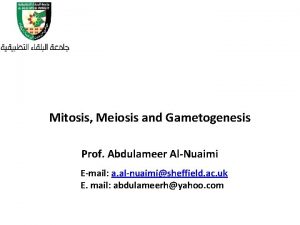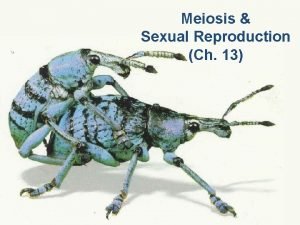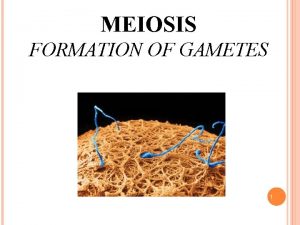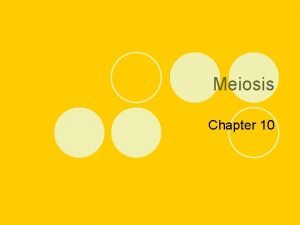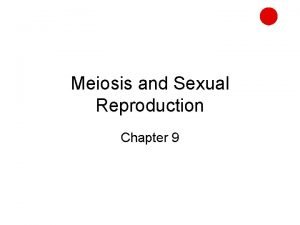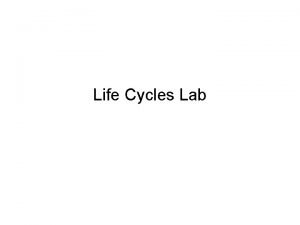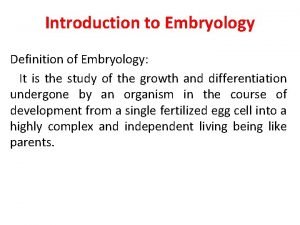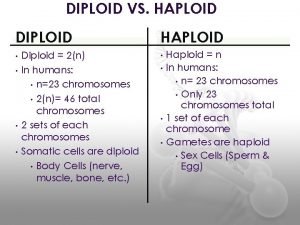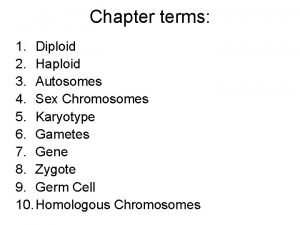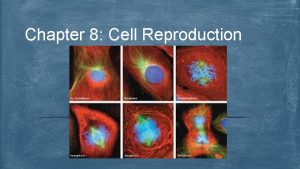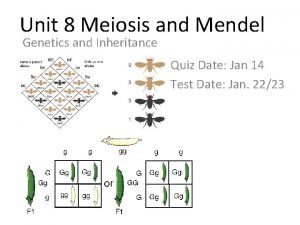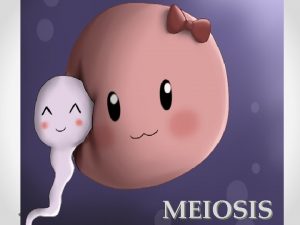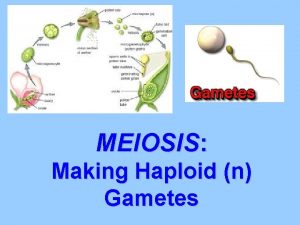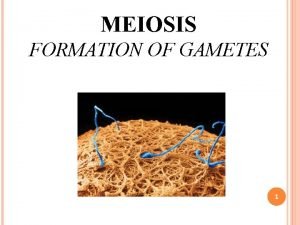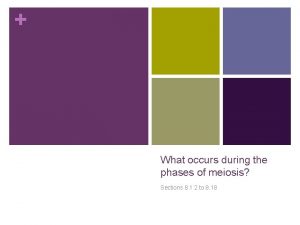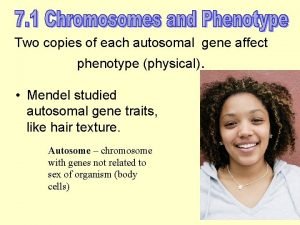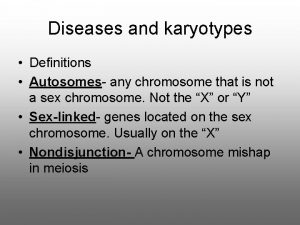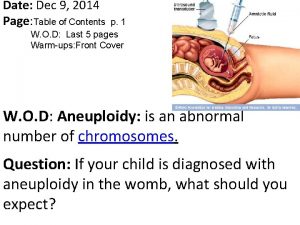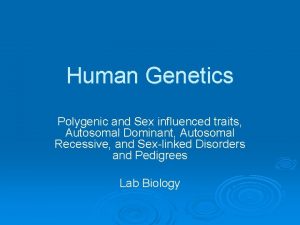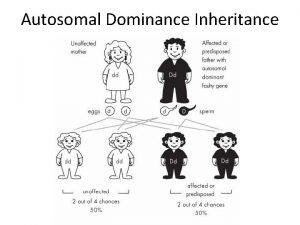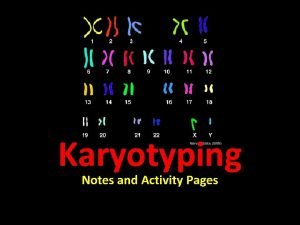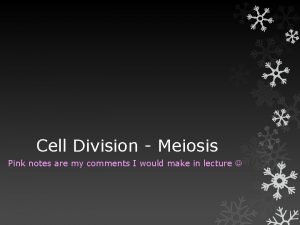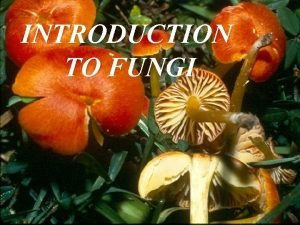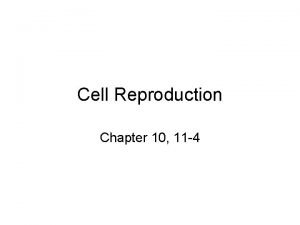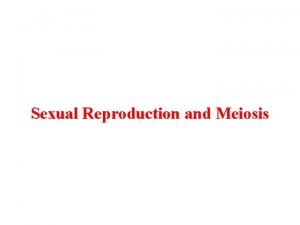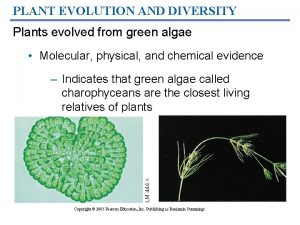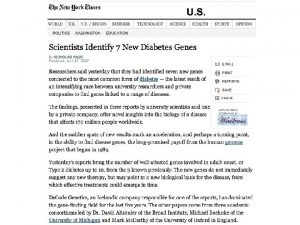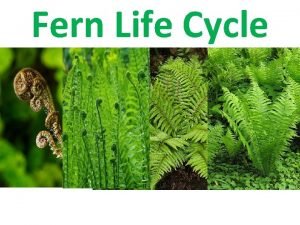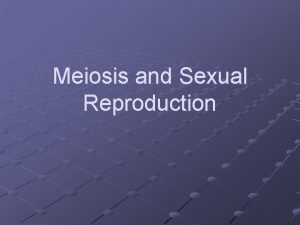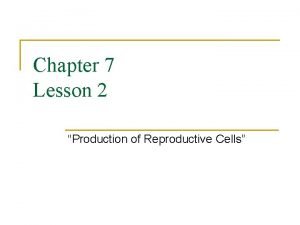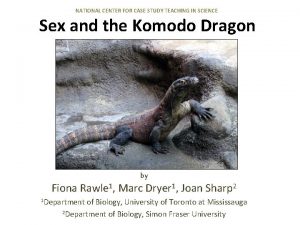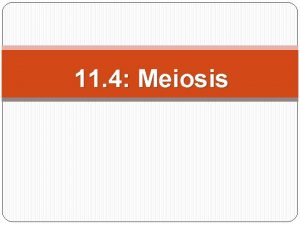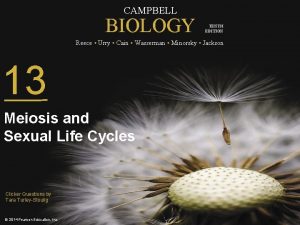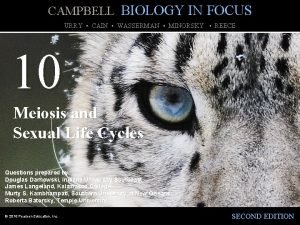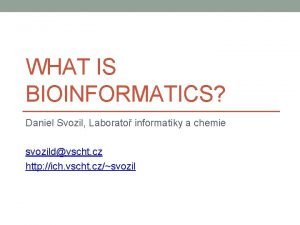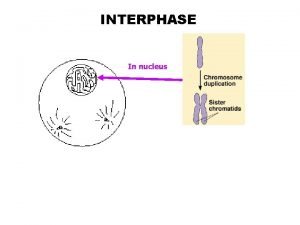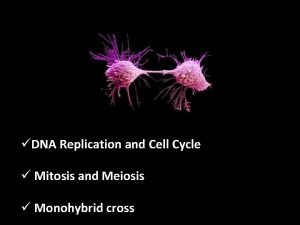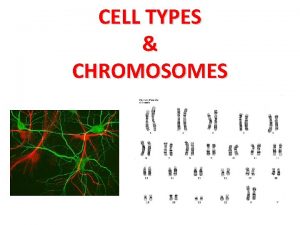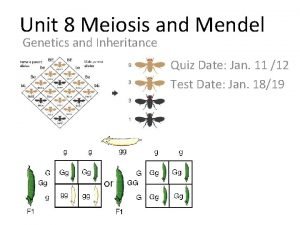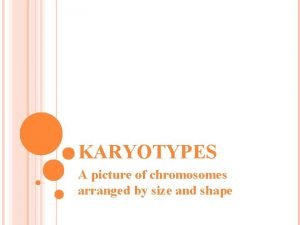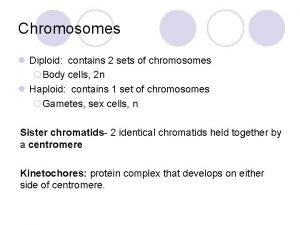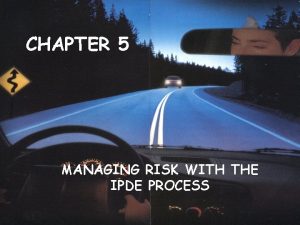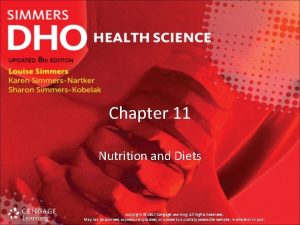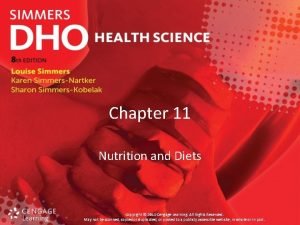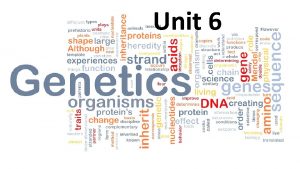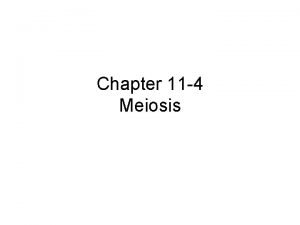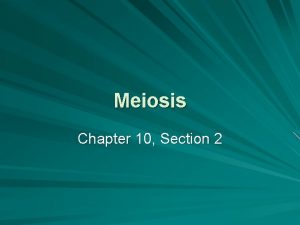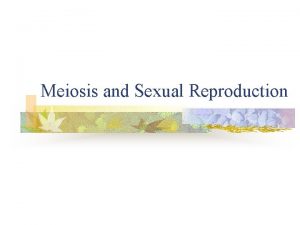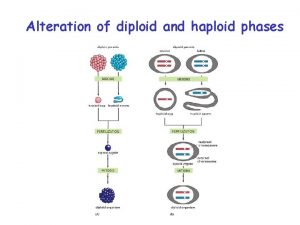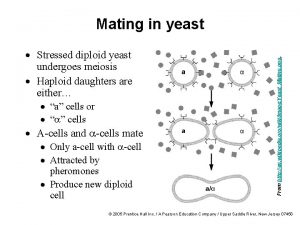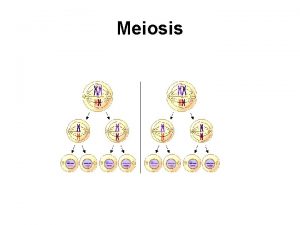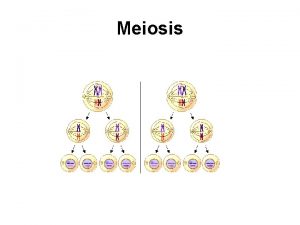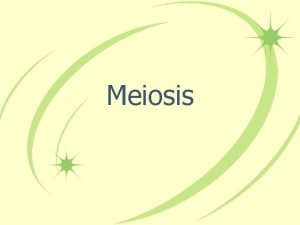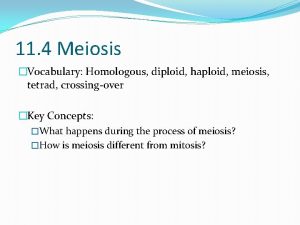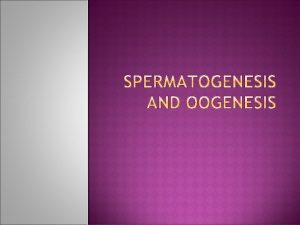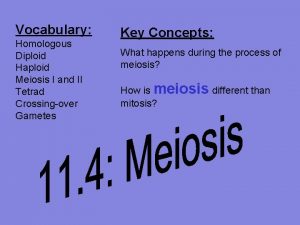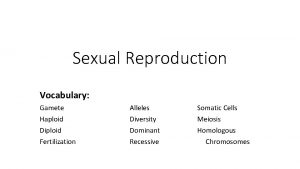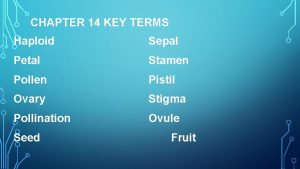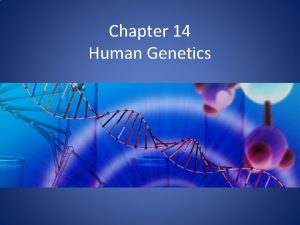Chapter terms 1 Diploid 2 Haploid 3 Autosomes




























































- Slides: 60

Chapter terms: 1. Diploid 2. Haploid 3. Autosomes 4. Sex Chromosomes 5. Karyotype 6. Gametes 7. Gene 8. Zygote 9. Germ Cell 10. Homologous Chromosomes

Development and Variation Welcome to club Zygota!

Club Zygota • Guess who’s photo this is on the left? • How did you get from that small to the size you are today? MITOSIS BABY!!

Parent and Daughter Cells • All organisms need to grow and reproduce. In multicellular organisms growth and reproduction involves the production of new cells from existing ones. • These newly formed cells are known as daughter cells, while the cells that they came from are known as the parent cells.

Parent and Daughter Cells For daughter cells to be produced by parent cells, two things must happen first: 1. Duplication of genetic material in the parent cell 2. Division of the parent cell into 2 separate cells

Parent and Daughter Cells • • The cell must have a control mechanism to ensure that each cell gets the correct amount of genetic material as well. This must be an EXACT measure because cells with too much or too little genetic material will often die.

Chromosomes • Genetic material is stored in structures known as chromosomes. • Chromosomes are made of a long molecule called deoxyribose nucleic acid, or DNA, wound around special proteins called histones.

Chromosomes • Some parts of DNA contain the instructions on how to build the proteins that will make up our physical traits (such as hair color, hair texture, etc. ). These parts of DNA are called our genes. • Genes are simply a portion of DNA that contain the “recipe” for how to build a protein.

Chromosomes • This picture is called a “karyotype”. A karyotype is a picture which shows all of the chromosomes from a somatic cell (body cell). • A normal human somatic cell contains 46 chromosomes, which is 23 pairs of homologous chromosomes

Karyotypes. Which one is male & which is female?

Chromosomes • Homologous chromosomes are chromosomes that are identical (actually, they are NEARLY identical) to each other in size, shape, and genetic material. • In other words, they are identical to each other in what genetic message they are “saying”.


The Phases of Mitosis • The first phase of mitosis is prophase: – During prophase the centrioles move to opposite sides of the nucleus, and spindles stretch out between them. – plant cells accomplish mitosis without centrioles

Prophase • Within the nucleus during prophase, each original chromosome along with it’s copy, condenses to form two identical chromatids. • These two identical chromatids are bound together with a structure in the center called a centromere. • Near the end of prophase, the nuclear membrane begins to break down as

Metaphase • • During metaphase, the chromosomes line up in the middle of the cell, and spindles attach to their centromeres. One chromatid is on either side of the middle of the cell.

Anaphase • • During anaphase, the centrioles begin to reel in the spindle fibers like a fishing rod. This pulls apart the centromere and separates the sister chromatids. The chromosomes slow down and stop as they reach the centriole.

Telophase • The last phase of mitosis is telophase. During this phase, nuclear membranes begin to form around the two new groups of chromosomes. • The chromosomes unwind into a tangled mass of chromatin strands. • The spindles break apart in anticipation of the completion of cell division.

Cytokinesis • After mitosis is complete, the cell divvies up the rest of the organelles and finally pulls apart in a process known as cytokinesis. • In animal cells the cell membrane pinches together to split into two new cells • In plant cells, a cell wall grows in to separate the two new cells.

Mitosis in a plant cell:


Duplicating Genetic Information

Chromosomes • Chromosomes number 1 -22 are called the autosomes. • The last set of chromosomes contain information that determines the sex of the individual, therefore they are called the sex chromosomes.

Chromosomes • The two sex chromosomes are not numbered, but rather are labeled either “X” or “Y”. • X X = Female • X Y = Male – Y’s are for guys

Mitosis vs. Meiosis • In multicellular organisms, there are two ways that a parent cell can give rise to a daughter cell. 1. Mitosis 2. Meiosis

Mitosis vs. Meiosis • • In mitosis, the parent cell duplicates its chromosomes and distributes them equally to the daughter cells. The purpose of mitosis is to produce two cells with the same number and kind of chromosomes as the parent cell.

Mitosis vs. Meiosis • • When a human cell undergoes mitosis, the parent cell will have 46 chromosomes (23 pairs), as will the daughter cells. Any cell with 2 copies of each chromosomes is termed diploid. (“di” = 2)

Diploid vs. Haploid Cells

Mitosis vs. Meiosis • • A diploid cell is often given the shorthand designation of 2 n. Any cell that has only half the number of chromosomes as a normal somatic cell is termed haploid, and is given the designation of 1 n, or sometimes simply “n”.


Mitosis vs. Meiosis • • • Mitosis is the way that diploid cells produce other diploid cells. Through mitosis, multicellular organisms grow, repair damaged tissues, and replace old or worn-out cells. Some single-celled organisms even reproduce via mitosis!

Mitosis vs. Meiosis • Cells that have been produced by mitosis, and thus have a complete set of chromosomes (2 of each) are sometimes called somatic cells.

Mitosis vs. Meiosis • The second way that cells have of making new cells is called meiosis. • Though mitosis happens to all different kinds of cells, meiosis happens to only one type of cell: germ cells.


Mitosis vs. Meiosis • Germ cells are cells in the body that are set apart only for the task of making cells that can be used for sexual reproduction. • These specialized cells that germ cells produce are called sex cells or gametes.

Mitosis vs. Meiosis • • In males, the gametes are known as sperm; while the female gametes are called eggs. The term “gamete” can be used interchangeably with “sex cell”, and it is common to encounter either term on tests.

Mitosis vs. Meiosis • Meiosis is a way of getting 4 daughter cells from just 1 parent cell, and where each of the daughter cells has only HALF the number of chromosomes of the parent cell.

Mitosis vs. Meiosis • When a cell has only half the number of chromosomes as a regular (somatic) cell, it is called haploid. – For example, human somatic cells have 46 chromosomes, but gametes have only 23 chromosomes.

Mitosis vs. Meiosis • Remember this: – Mitosis gives daughter cells that are identical to parent cells. (diploid) – Meiosis leads to daughter cells that have half the number of chromosomes as the parent cells. (haploid)

Mitosis vs. Meiosis Table (answers) 1. Purpose of process in multicellular organisms Mitosis Meiosis Growth, repair, replace worn out or dead cells Production of gametes for use in sexual repro. 2. Number of daughter cells produced 2 4 3. Number of chromosomes in parent cell (human) 46 (23 pairs) 4. Number of chromosomes in one daughter cell (human) 46 (23 pairs) 23 (23 unpaired chromosomes) 5. Daughter cells diploid (2 n) or haploid (n)? Diploid (2 n) Haploid (n) 6. Daughter cells genetically identical to parent cell? Yes No 7. Daughter cells genetically identical to each other? Yes No

The Cell Cycle • Mitosis & Meiosis are part of the cell cycle. • The cell cycle can range from only a few hours up to a few days, depending on what type of cell is dividing. • The stages of the cell cycle are shown to the right (and in the next slide. )


The Cell Cycle • The cell cycle has two main parts: – Growth phase (interphase) – Division phase (Mphase or Mitosis phase) • Most of the cell’s time is spent in interphase, where it grows and prepares for division.

The Cell Cycle • Interphase is made up of three subphases: – G 1 (growth phase 1) The cell enlarges itself by making proteins and organelles – S phase (DNA synthesis phase) The cell duplicates its chromosomes (DNA) – G 2 (growth phase 2) The cell grows still larger and prepares for division by making organelles called spindles (as well as centrioles in animal cells)

The Cell Cycle • • After interphase comes the M phase (or mitotic phase), when cell division actually occurs. M-phase is made up of 4 distinct sub-phases: 1. 2. 3. 4. Prophase Metaphase Anaphase Telophase

The Cell Cycle • • The 4 stages of the Mphase (Prophase, Metaphase, Anaphase, & Telophase) make up the process known as mitosis. During cytokinesis (which happens after mitosis is finished), the entire cell splits into two genetically identical daughter cells.

The Cell Cycle • After cytokinesis, the cell cycle is complete, and the daughter cells are ready to repeat the process. Cytokinesis

The Cell Cycle • • Cells divide when they grow large enough or after they are given external cues such as hormones. Certain glycoproteins on neighboring cells give cells the cue to stop dividing (kinda like “Stop, the neighborhood is getting too crowded!”)

The Cell Cycle • • Some cells divide very quickly and often. Epithelial cells (skin) and intestinal cells can divide multiple times every day. Some cells do not divide and reproduce at all! Cardiac cells and many types of neural cells generally do not reproduce at all. So what you have is all you get…TAKE CARE OF IT WISELY!


The Cell Cycle To remember the phases of the cell cycle: – IPMAT-C OR – “I Pee’d My Awesome Trousers Coach!” • • • Interphase Prophase Metaphase Anaphase Telophase Cytokinesis

Meiosis • Organisms that reproduce sexually must undergo meiosis. • During meiosis, special cells in the ovaries or testes called germ cells undergo a series of divisions that result in gametes with half the number of chromosomes as the rest of the cells.

Meiosis • In humans, this means that the gametes (eggs and sperm) carry only 23 chromosomes, whereas normal somatic cells contain 46. • These gametes cannot form a viable organism until they fuse together during fertilization.

Meiosis • Meiosis is very much like mitosis except that the cells undergo an extra cycle of division without replicating their DNA. • This ensures that each gamete gets only one copy of each chromosome.

Meiosis • Meiosis in animals produces either 4 sperm from 1 parent cell, or 1 egg & 3 polar bodies from 1 parent cell. • The reason that only one egg arises from meiosis is that one of the gametes ends up with most of the cytoplasm, and the other three cells (polar bodies) do not participate in reproduction.






 Primary oocyte haploid or diploid
Primary oocyte haploid or diploid Primary spermatocyte
Primary spermatocyte Anapjase
Anapjase Haploid and diploid
Haploid and diploid Primary oocyte haploid or diploid
Primary oocyte haploid or diploid Primary oocyte haploid or diploid
Primary oocyte haploid or diploid Meiosis
Meiosis Meiosis
Meiosis Haploide zelle
Haploide zelle Nucleus of primary oocyte
Nucleus of primary oocyte Diploid vs haploid number
Diploid vs haploid number Diploid vs haploid
Diploid vs haploid Diploid vs haploid number
Diploid vs haploid number Haploid vs diploid
Haploid vs diploid Genotypic ratio
Genotypic ratio How are somatic cells different from gametes
How are somatic cells different from gametes Anaphase of mitosis
Anaphase of mitosis 2n haploid or diploid
2n haploid or diploid First polar body
First polar body Gamete vs zygote
Gamete vs zygote Difference between autosomes and sex chromosome
Difference between autosomes and sex chromosome Disorder
Disorder Autosomes vs sex chromosomes
Autosomes vs sex chromosomes Autosomes and sex chromosomes
Autosomes and sex chromosomes Autosomes
Autosomes Whats an autosome
Whats an autosome Edwards syndrome
Edwards syndrome Autosomes
Autosomes Genetics
Genetics Like terms and unlike terms in polynomials
Like terms and unlike terms in polynomials Combining like terms lesson
Combining like terms lesson Haploid
Haploid What is a haploid cell?
What is a haploid cell? Haploid
Haploid Gametangial contact in fungi
Gametangial contact in fungi Haploid number
Haploid number Fonte
Fonte Produces haploid cells
Produces haploid cells Marchantiophyta
Marchantiophyta Haploid
Haploid Ploidy
Ploidy Plant life cycle alternation of generations
Plant life cycle alternation of generations Number of chromosomes in haploid cells in a king crab
Number of chromosomes in haploid cells in a king crab Haploid cells def
Haploid cells def If a diploid egg was produced by mitosis
If a diploid egg was produced by mitosis Diploid cells
Diploid cells Privet shrubs and humans each have a diploid number of 46
Privet shrubs and humans each have a diploid number of 46 Privet shrubs and humans each have a diploid number of 46
Privet shrubs and humans each have a diploid number of 46 What is diploid
What is diploid Diploid cell
Diploid cell Dr nabil hasan
Dr nabil hasan Diploid cell
Diploid cell Diploid cell
Diploid cell Chromosome number of human
Chromosome number of human Diploid cell
Diploid cell Pictures of chromosomes arranged in pairs
Pictures of chromosomes arranged in pairs Diploid contains 2 sets of chromosomes
Diploid contains 2 sets of chromosomes Chapter 5 section 3 the minor parties answer key
Chapter 5 section 3 the minor parties answer key Ipde process definition
Ipde process definition Chapter 11 nutrition and diets
Chapter 11 nutrition and diets Chapter 11 nutrition and diets
Chapter 11 nutrition and diets
